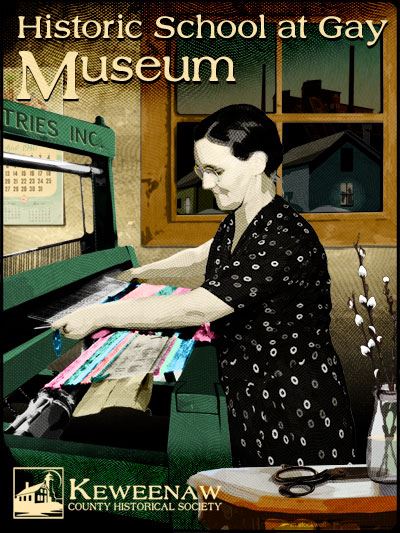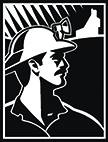
AFTER the MILL: GAY INDUSTRIES
When the Mohawk Mill closed in 1932 during the Great Depression, over half of the town’s working population lost their jobs. Today, only the concrete ruins and the smokestack remain.
President Roosevelt’s New Deal created many jobs in the late 1930s to energize the economy. Through newly created Federal agencies, such as the Civilian Conservation Corps, the National Youth Administration, and the Works Progress Administration (WPA), many men and women in Gay found employment. By 1940, nearly half of the workers in Gay were working for these Federal programs in road construction, tourism, recreation, reforestation, and sewing in locations throughout the Peninsula.
The WPA established several textile-based projects in the area including rug weaving in Gay, and linen weaving in Baraga. The WPA had workers construct two looms for women to weave rag rugs under the name “Gay Industries.” The finished rag rugs were sold at the Keweenaw Handicraft shop on US-41 near Mohawk. The shop, built in 1936, signaled a shift in the area’s economy towards tourism. Besides selling Gay Industries projects, they provided information about the local area to tourists, and counted the number of cars entering Keweenaw County.
The weavers at Gay Industries sold their rugs in this log structure built by the WPA in the 1930s. It operated as an information center for many years. After a period of closure it was reopened in 1965 as the Keweenaw Craft Shop, operated by the Community Action Council. Credit: Allison (Kim) Hoagland, 2018. The Log Cabin: An American Icon
Rag-rug weaving is rooted in local Finnish heritage. Typically, women worked in their homes on wooden counterbalance looms often passed down as family heirlooms. They wove strips torn from used clothing into multicolored, patterned rag-rugs which were used until they were worn out, then repurposed to stop drafts, or as door mats.
Rugs from the looms on sale at the museum. Courtesy: Mark Rhodes. 2021.
In the 1970s, women from the Fire Belles Ladies’ Auxiliary of Gay used the original WPA looms, along with others acquired by the Keweenaw Historical Society, to weave rugs sold at the Auxiliary’s weekly rummage sale in the township hall. Money was used to support the volunteer Fire Department. One weaver recalls…
“The women would meet upstairs of the current office building called the “loom room,” and cut apart used clothing. From these parts, strips would be cut. These strips would be joined and made into balls. They would then wind the strips onto a shuttle. This would pass easily through the warp. The weaver would then tamp the weft strongly and continue weaving.
The large green Gay Industries looms are still in use today. Many additional looms have been donated since the original Gay Industries looms were relocated to this building. Volunteers create table runners and rugs that are sold with the proceeds going to the Gay School Museum.
Look carefully at the large green Gay Industries looms, and you will find tally marks showing completed rugs dating back to at least 1941. Courtesy: Mark Rhodes. 2021.
The looms are still sometimes used for demonstrations during the museum’s open hours. Courtesy: Mark Rhodes. 2021.
Some WPA projects in Keweenaw County focused upon the development of tourism which continued after World War II. As one of the few tourists stops on the eastern side of the Keweenaw, Gay gradually became a home for retirees and for returning families from the milling, fishing, and lumbering days. Daily Mining Gazette. October 29, 1955.

Gay Industries circa 1940. Illustration by Mike Stockwell



